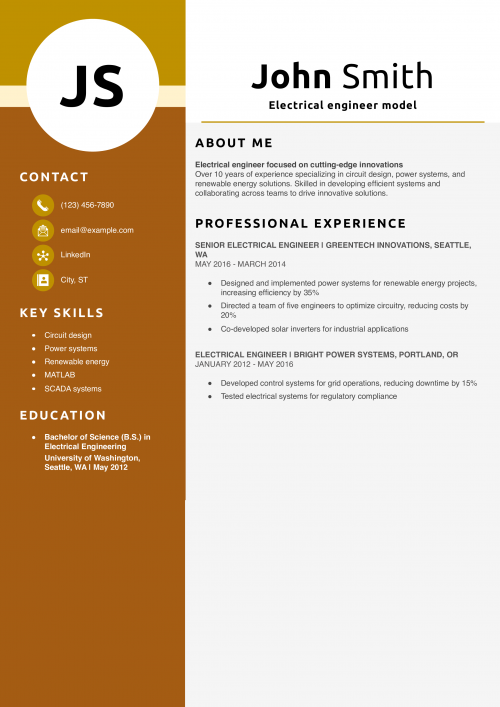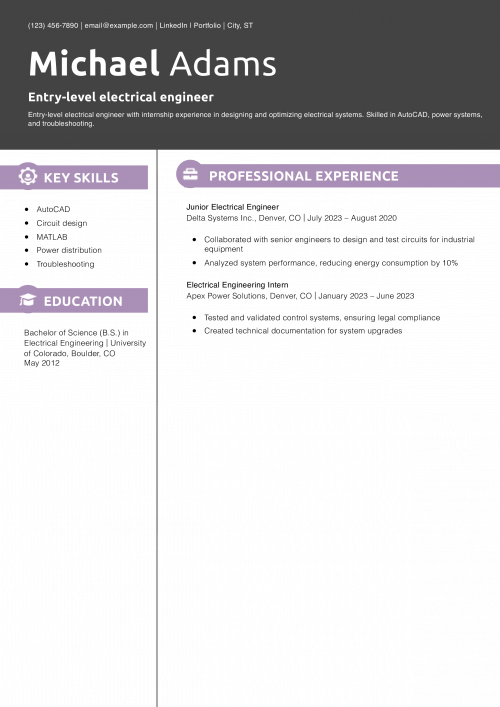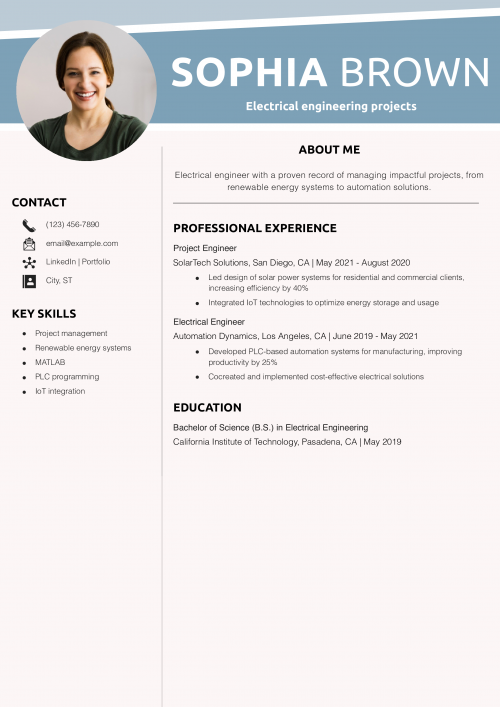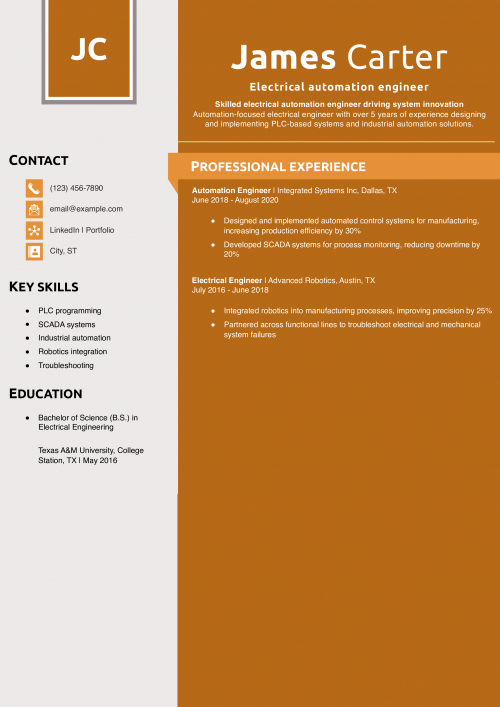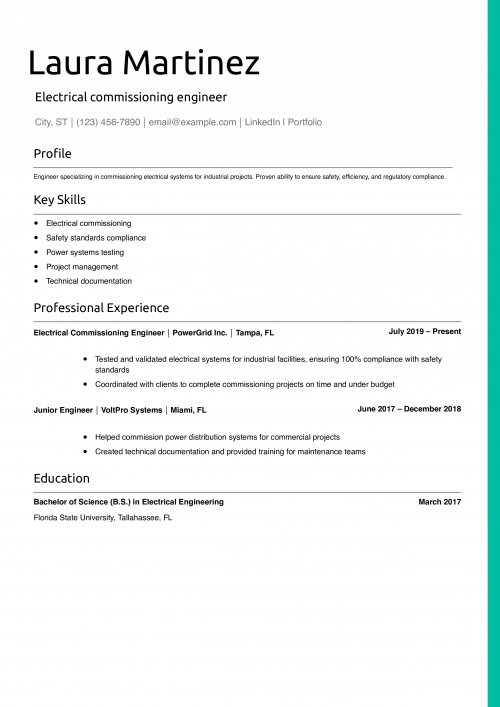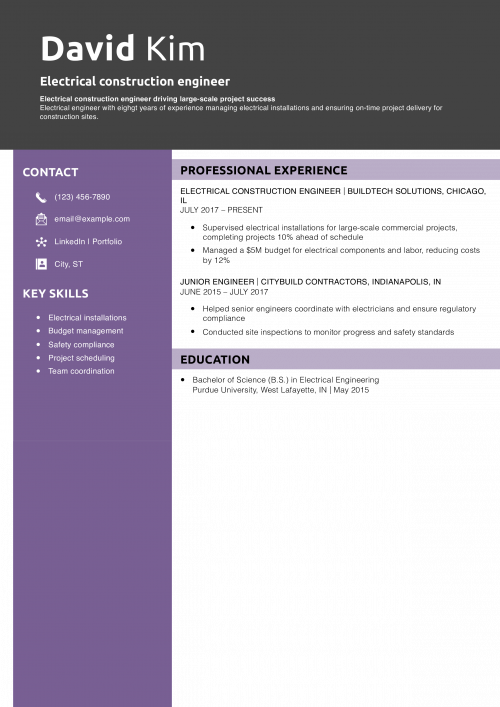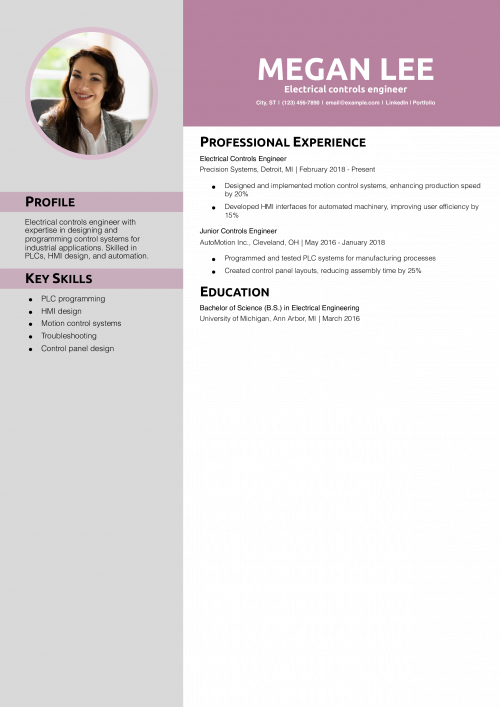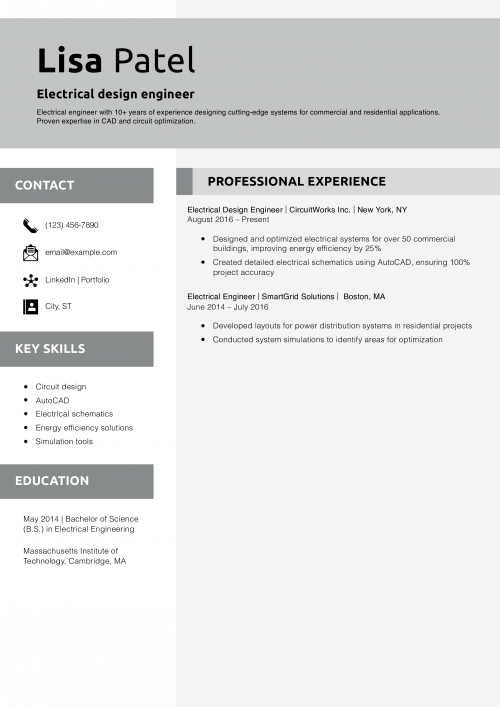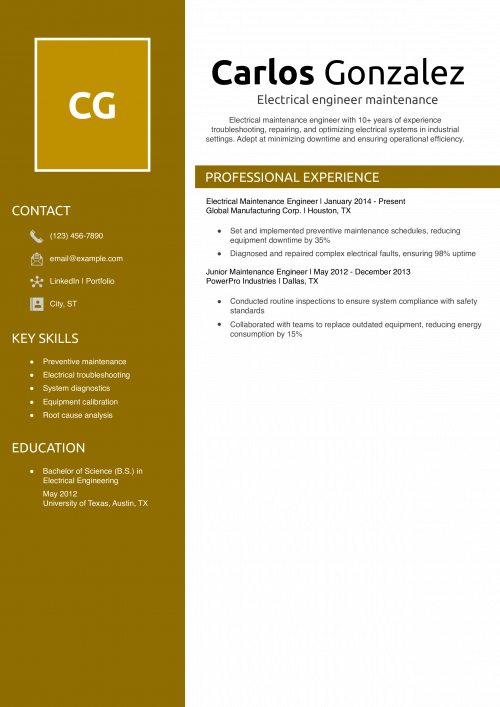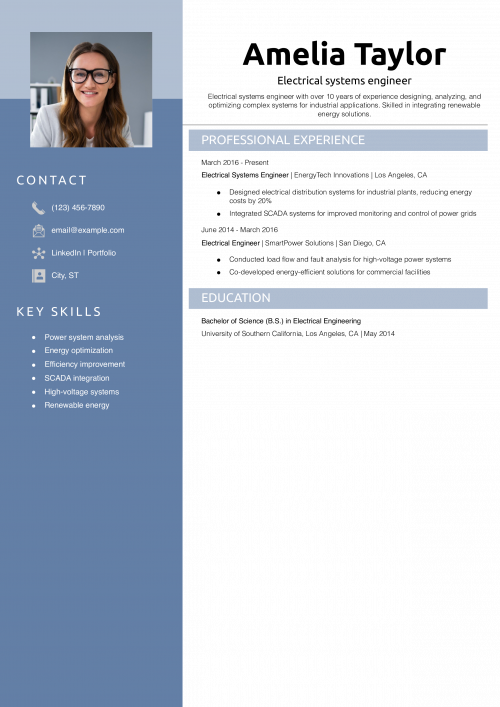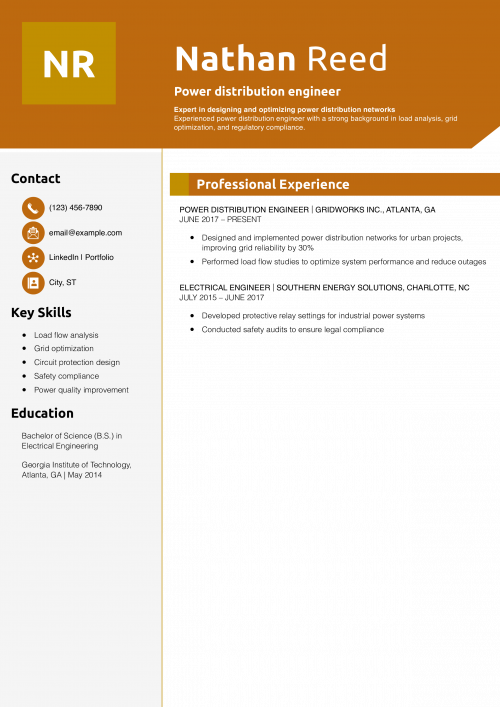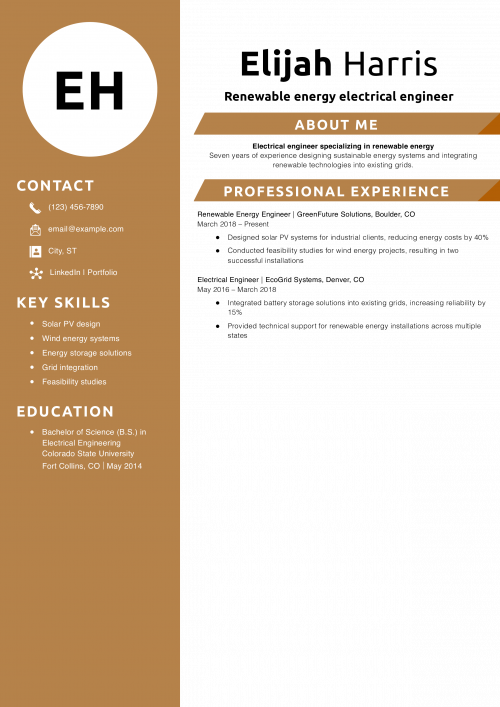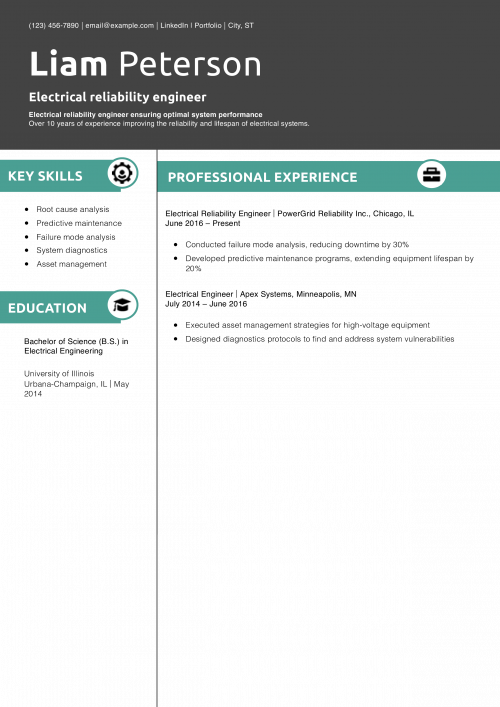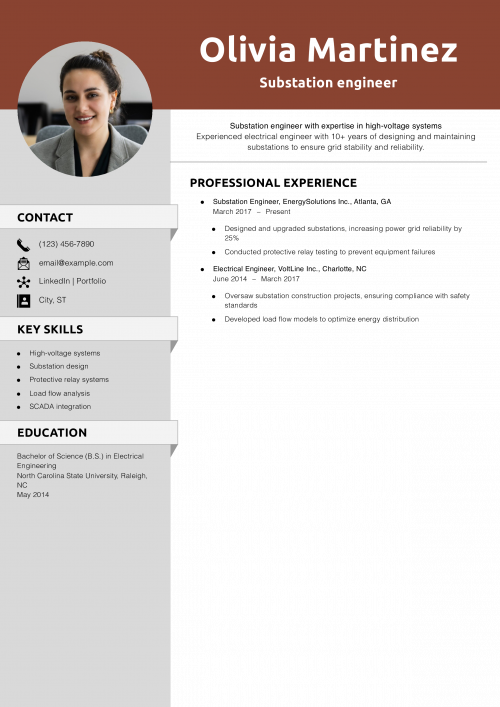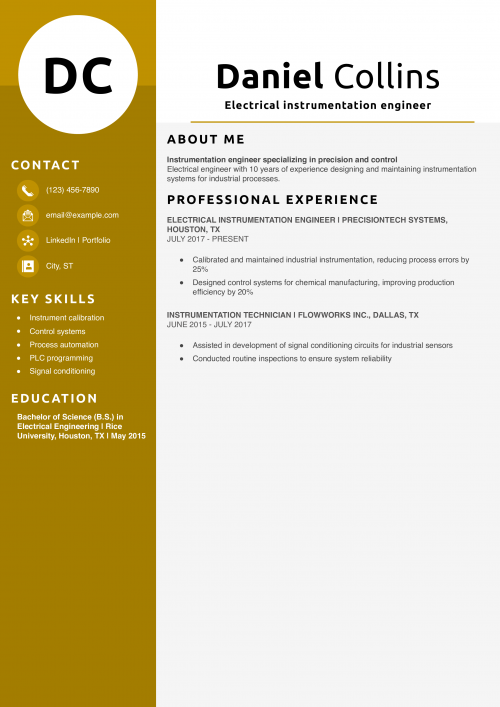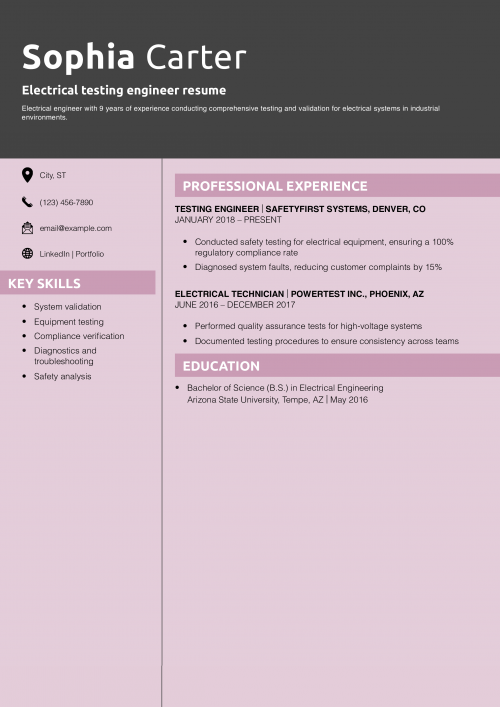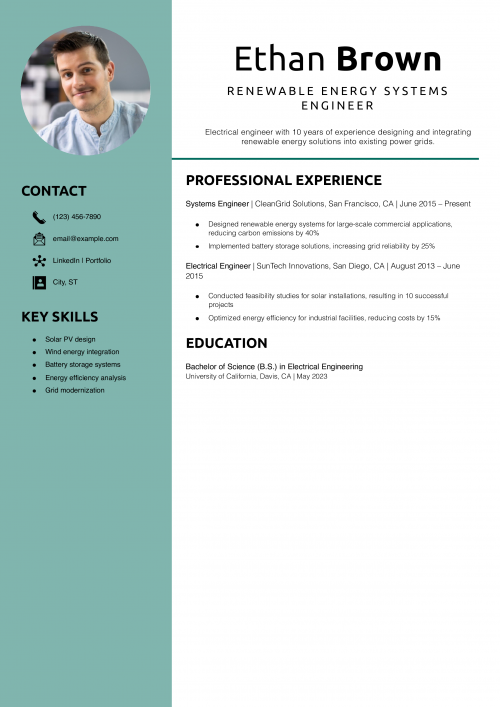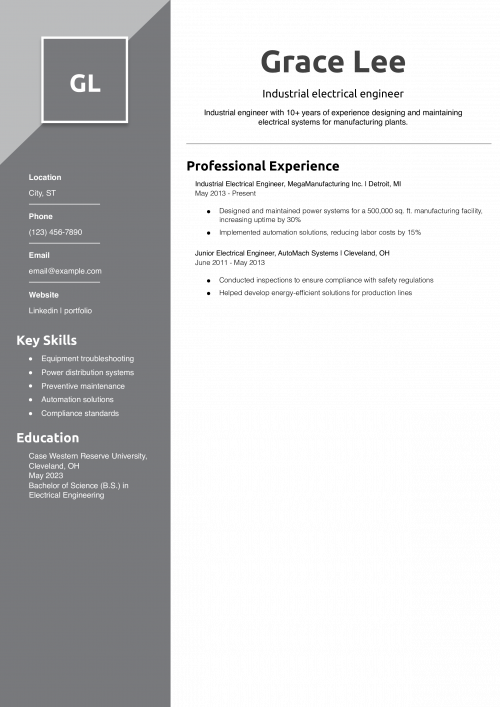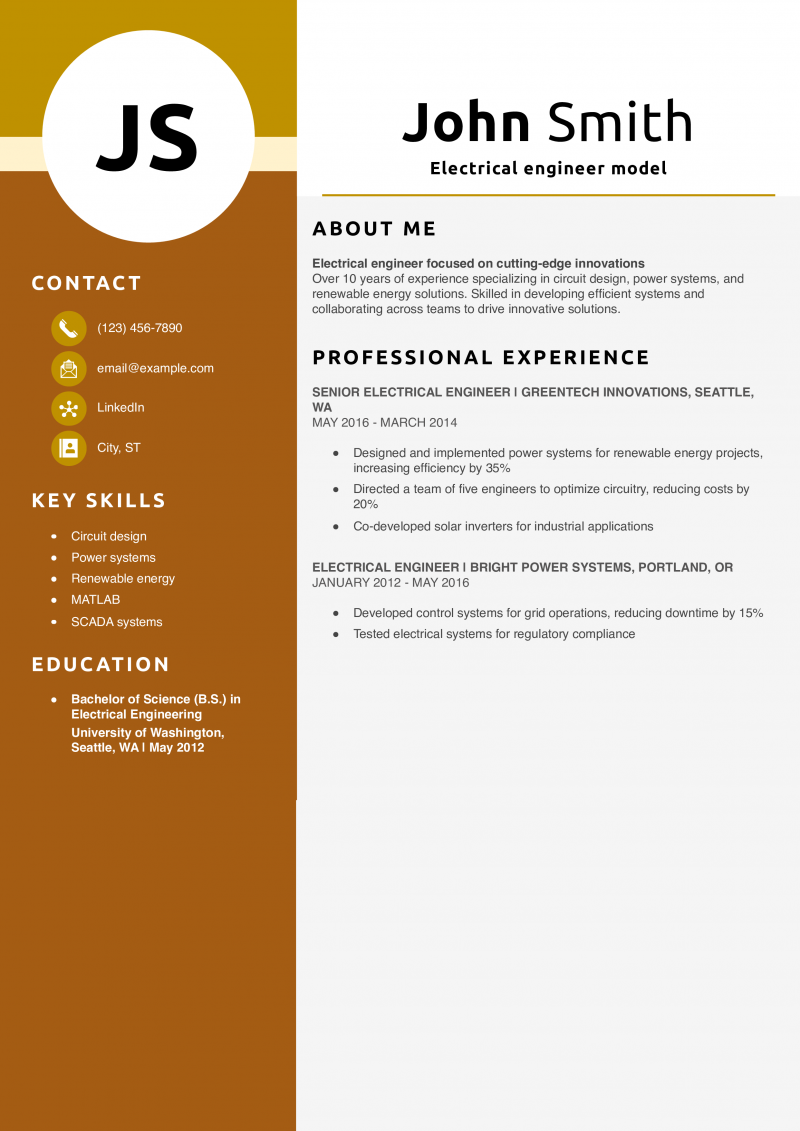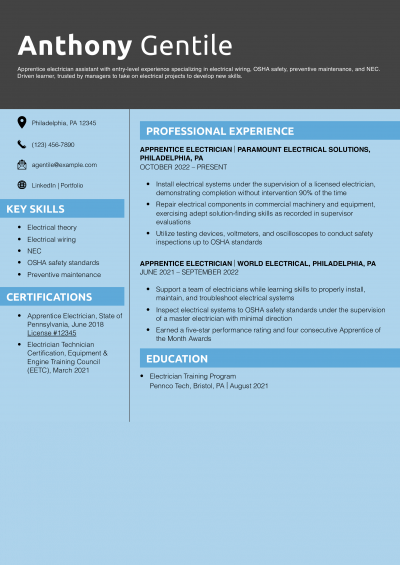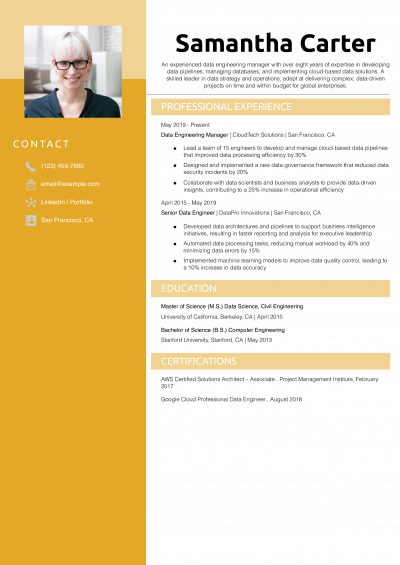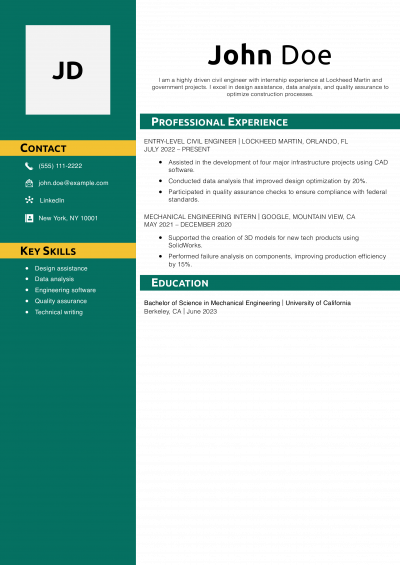A good electrical engineer resume focuses on your main strengths, like circuit design, power systems, or technical troubleshooting. Give examples of your success in similar engineering roles, and show your knowledge base by citing any degree or certificate programs you’ve completed. This guide provides expert tips to help you create a persuasive resume showing your best electrical engineer skills.
Key takeaways:
- Brainstorm details about your work history on a separate document or sheet of paper. Then, identify the most relevant ones to feature in your experience section – this helps you focus your resume on the role of electrical engineer.
- Spell out the results of your past work as an electrical engineer. Describe how your efforts helped clients or organizations solve complex problems.
- Use bullet points to display your achievements. Start each bullet point with a strong verb like “Designed,” “Created,” or “Enhanced.”
Most Popular Electrical Engineer Resumes
Electrical Engineer Model Resume Example
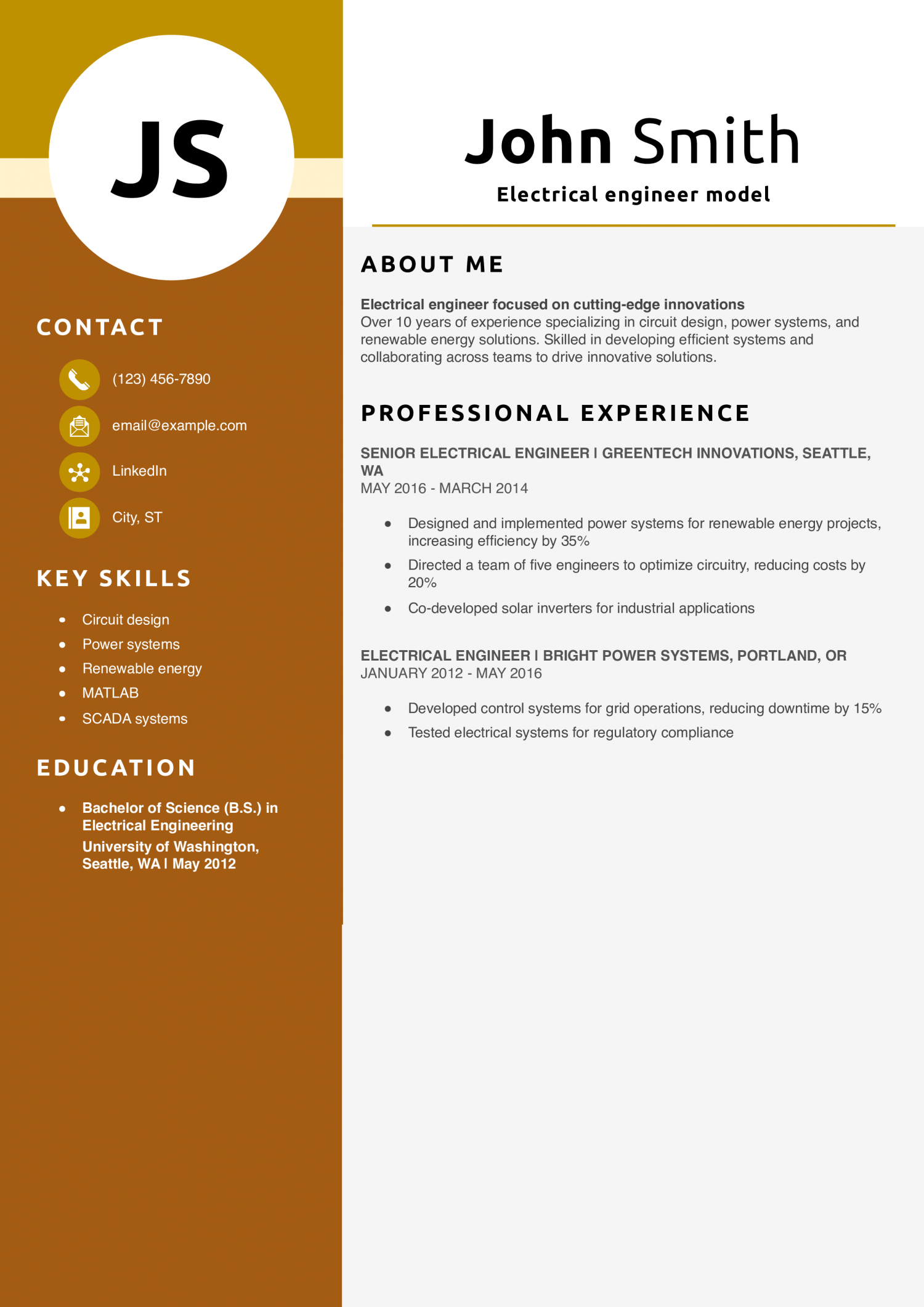
Why this electrical engineer model resume is strong:
This resume highlights experience with a focus on renewable energy, efficiency improvement, and technical expertise in power systems. Learn how to craft a professional summary like this here.
Electrical Engineering Student Resume Example
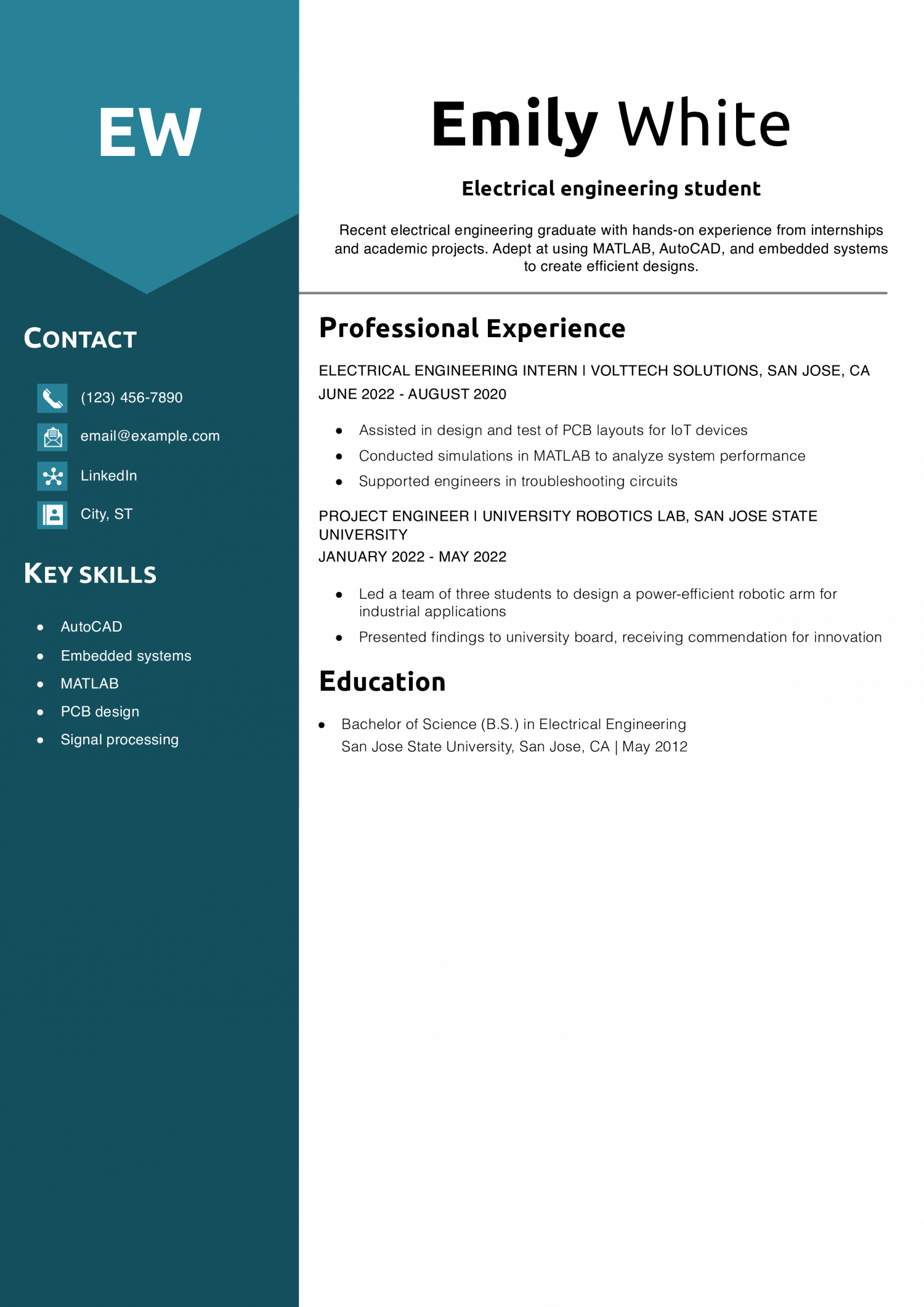
Why this electrical engineering student resume is strong:
This example emphasizes relevant internships, technical projects, and academic achievements, making it ideal for entry-level candidates. Learn how to list educational qualifications effectively here.
Entry-level Electrical Engineer Resume Example
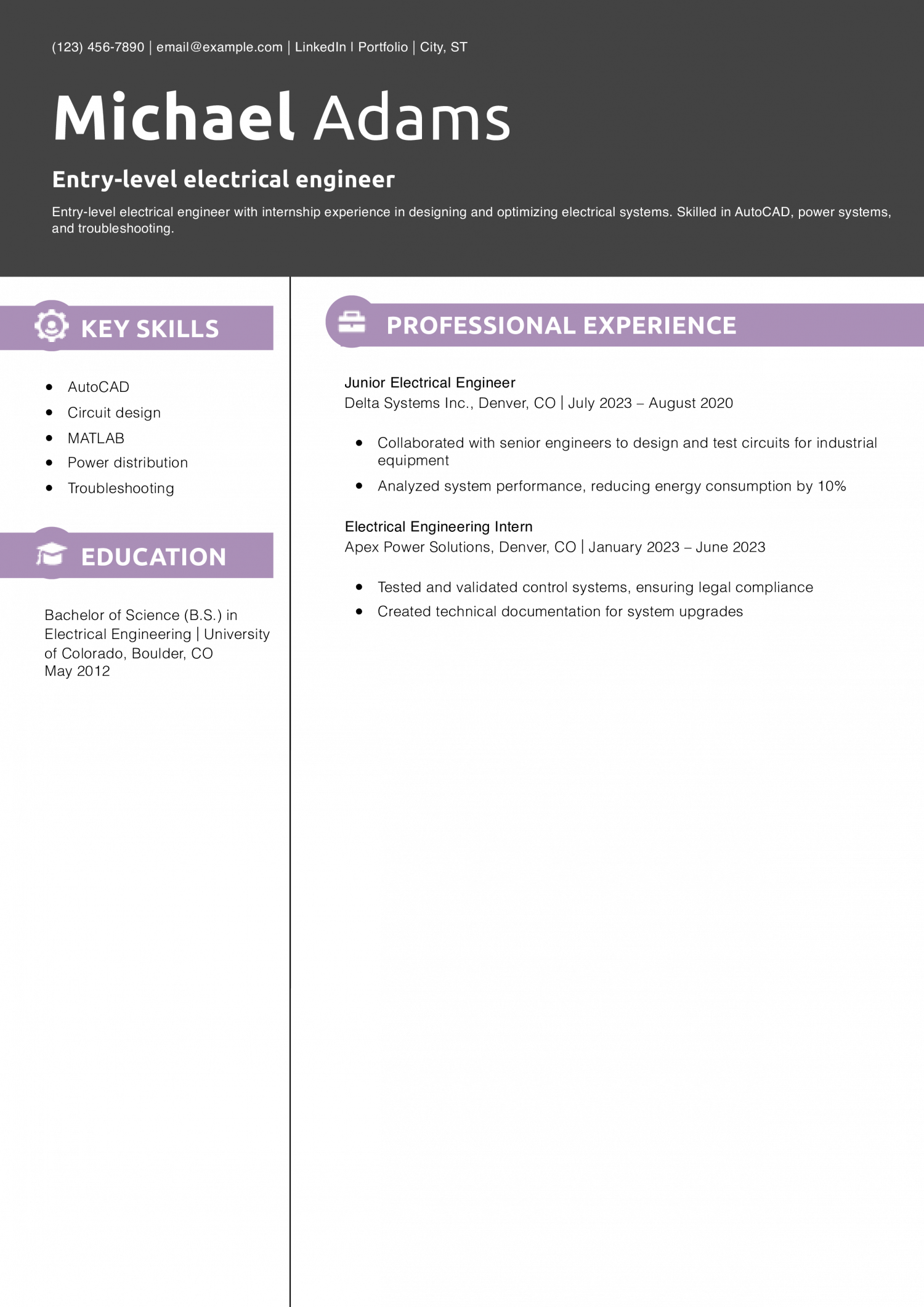
Why this entry-level electrical engineer resume is strong:
This resume highlights relevant internship experiences and technical skills for candidates just starting their careers. Learn how to write a compelling entry-level resume here.
Electrical Engineering Projects Resume Example
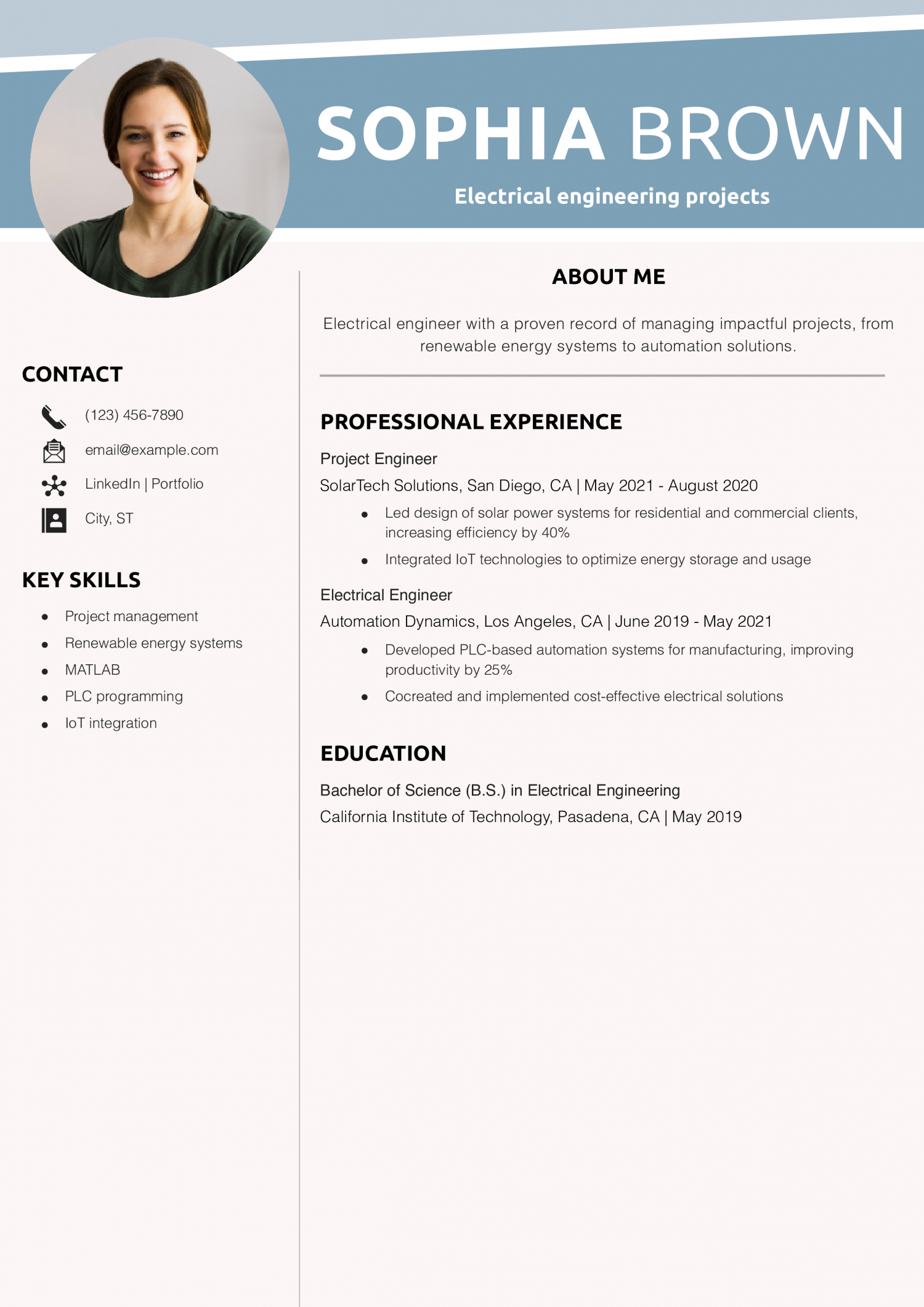
Why this electrical engineering projects resume is strong:
This resume focuses on project management and quantified achievements. Learn how to highlight technical projects and skills here.
Electrical Automation Engineer Resume Example
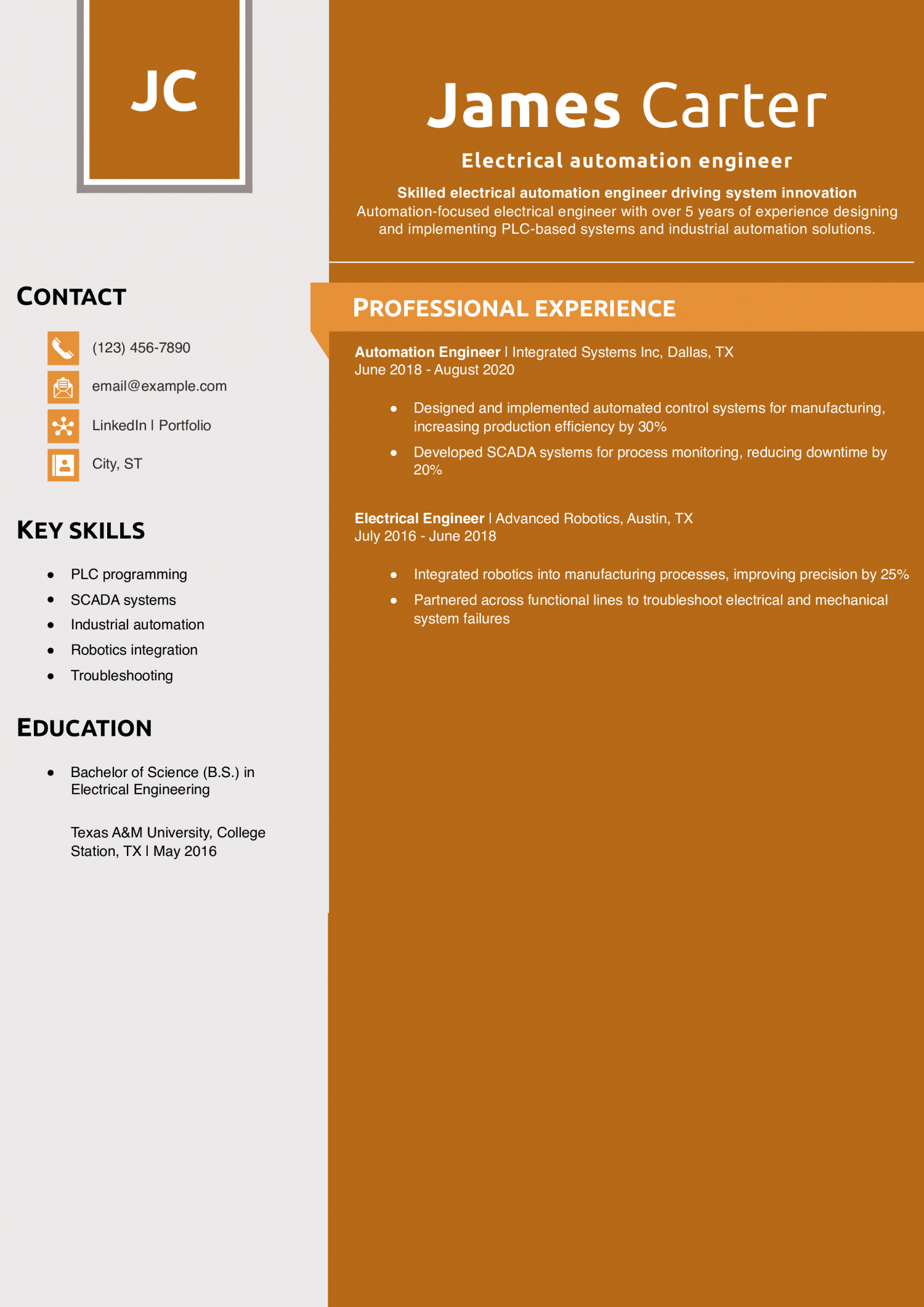
Why this electrical automation engineer resume is strong:
This resume highlights a specialized focus on automation and quantifiable achievements in efficiency and precision. Discover tips for showcasing technical expertise here.
Electrical Commissioning Engineer Resume Example
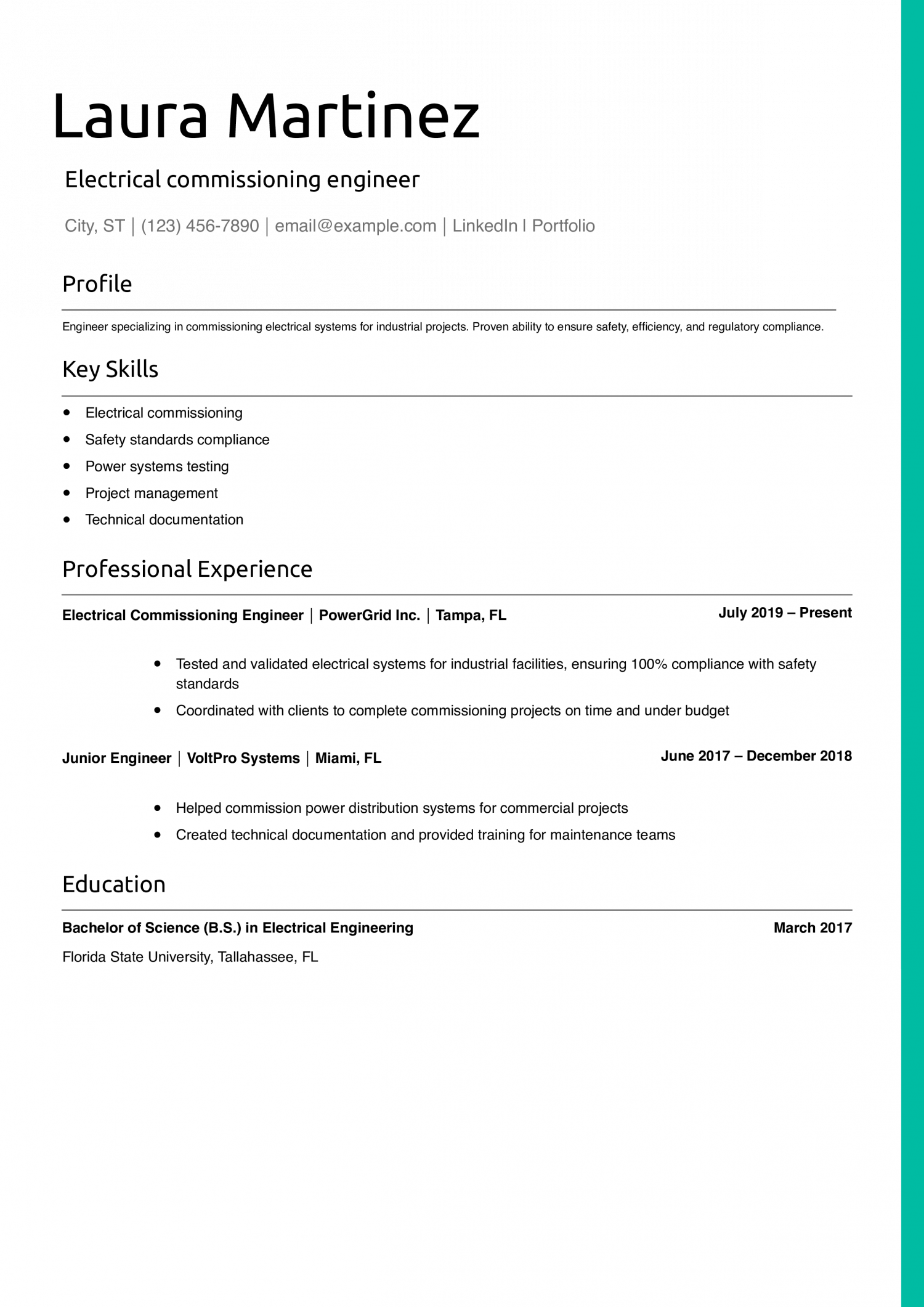
Why this electrical commissioning engineer resume is strong:
This resume emphasizes specialized skills in commissioning and strong project outcomes, showing a firm grasp of safety and compliance. Read more: How To List Skills in Your Resume Skills Section
Electrical Construction Engineer Resume Example
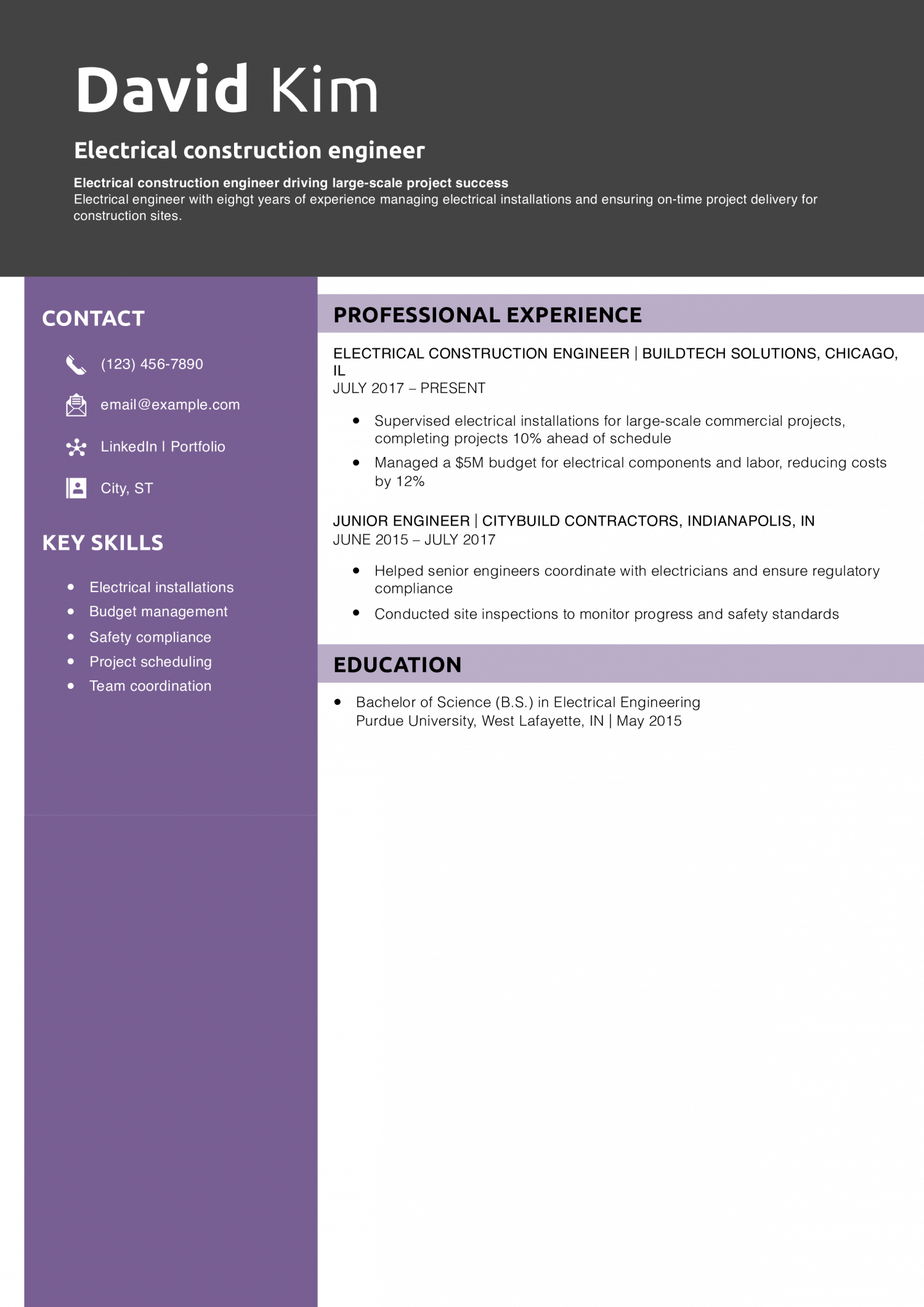
Why this electrical construction engineer resume is strong:
This resume demonstrates leadership and project management skills alongside quantifiable outcomes like cost savings. Learn more about showcasing leadership on your resume here.
Electrical Controls Engineer Resume Example
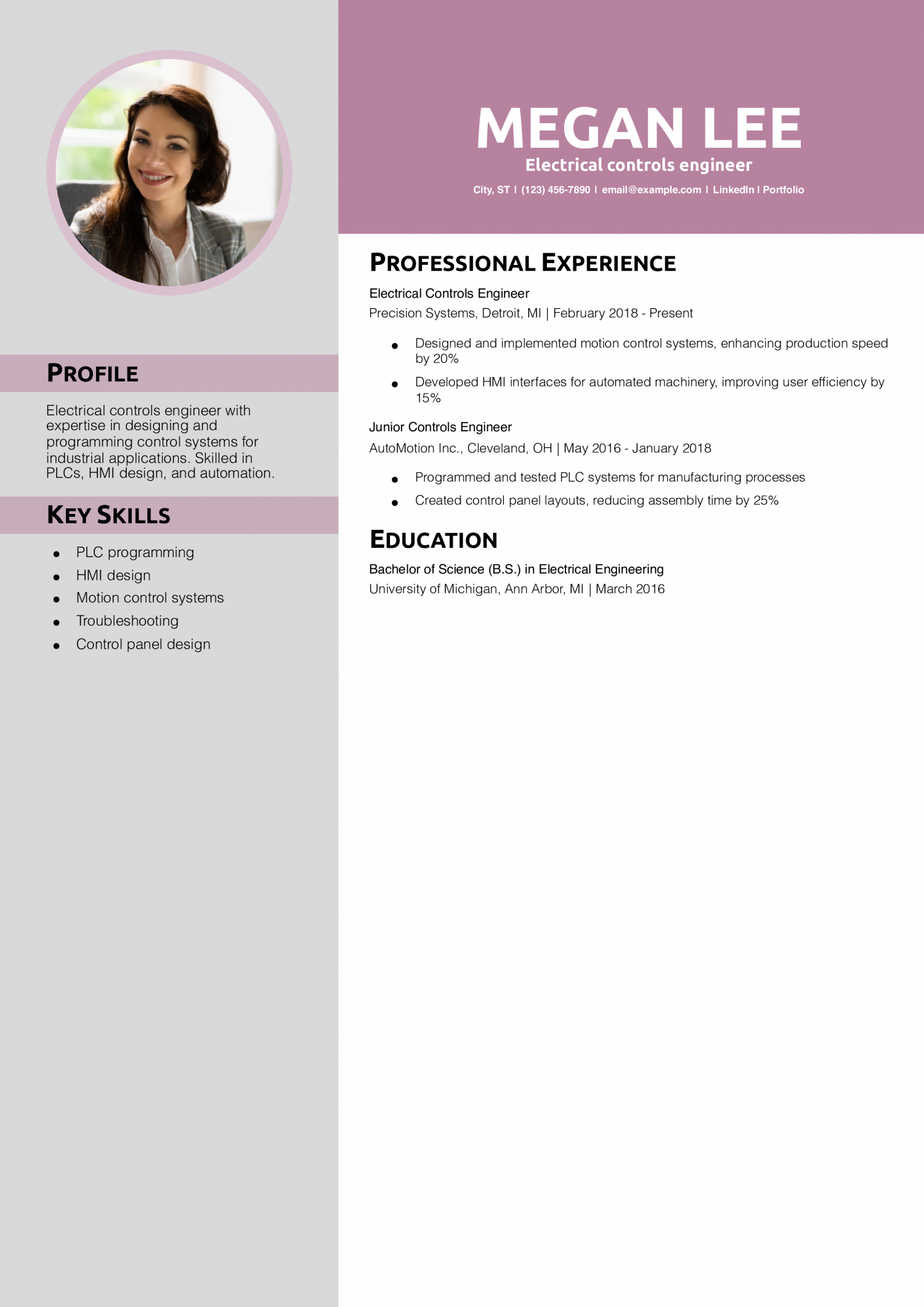
Why this electrical controls engineer resume is strong:
This resume highlights expertise in control systems and automation, supported by quantifiable results like production speed improvements. Learn how to emphasize technical skills effectively here.
Electrical Design Engineer Resume Example
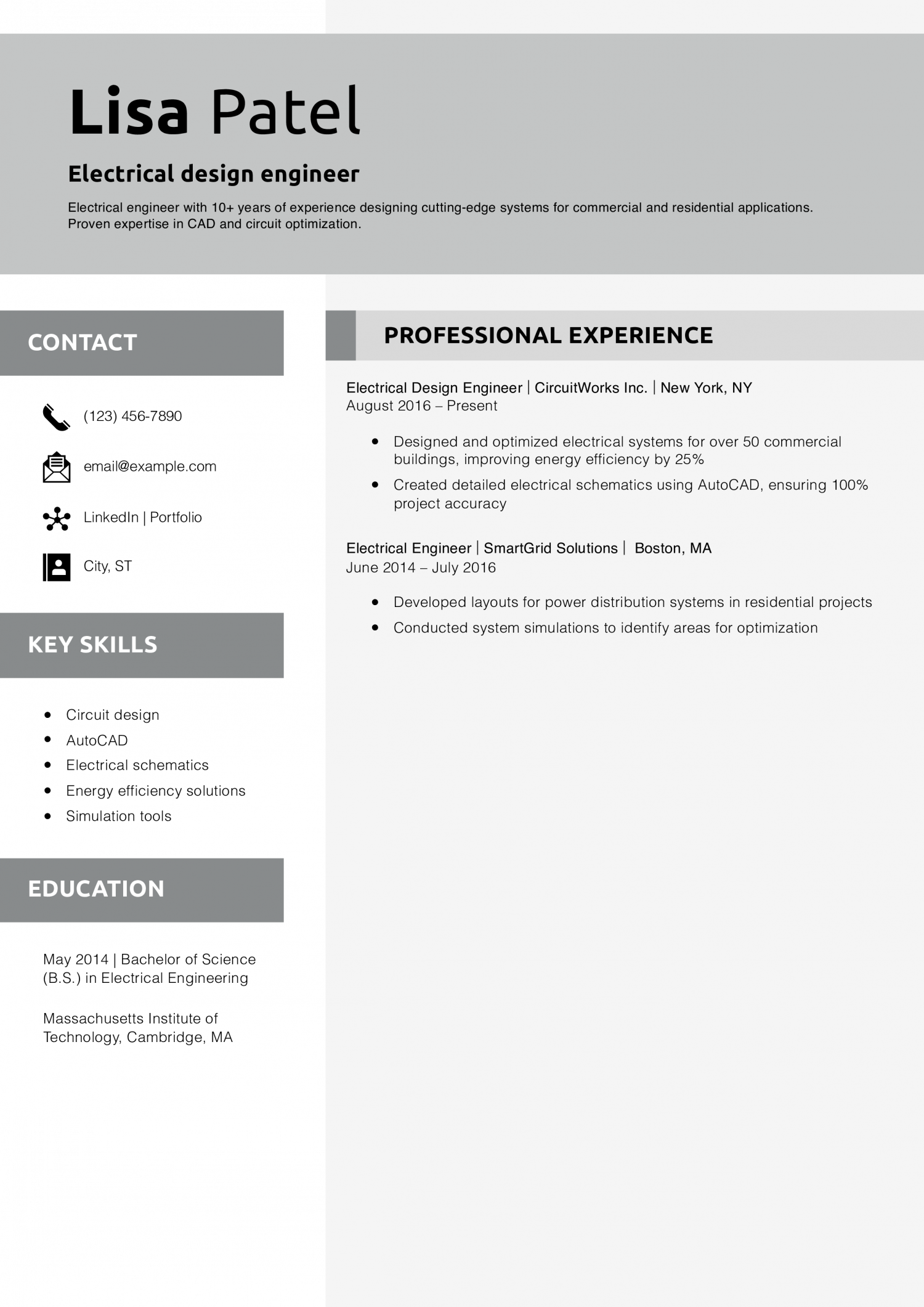
Why this electrical design engineer resume is strong:
This resume highlights design expertise, energy efficiency contributions, and proficiency with simulation tools. Learn how to make your resume visually appealing here.
Electrical Engineer Maintenance Resume Example
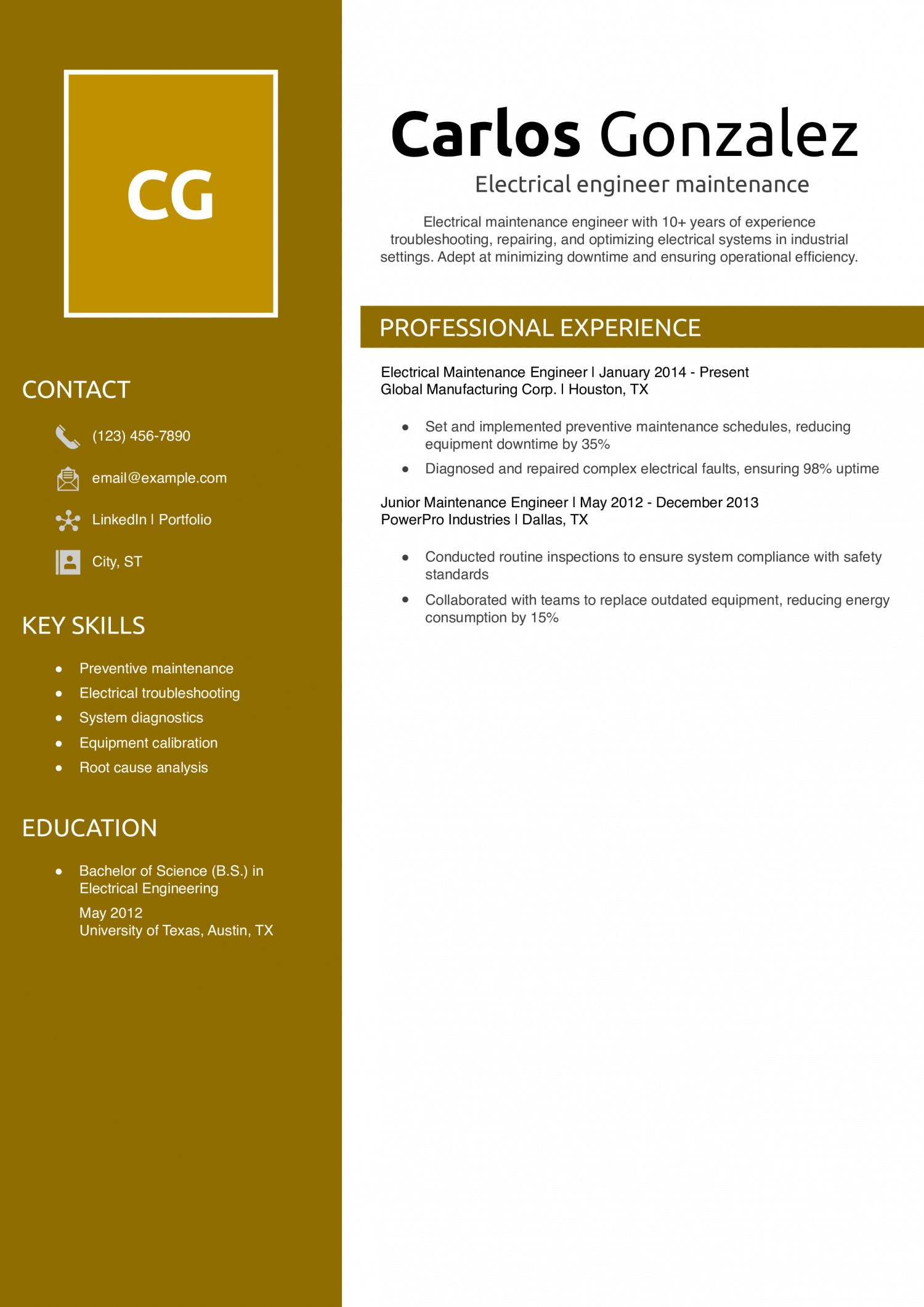
Why this electrical engineer maintenance resume is strong:
This resume demonstrates strong problem-solving skills with measurable results, such as reducing downtime and optimizing energy use. Learn how to highlight technical troubleshooting skills here.
Electrical Systems Engineer Resume Example
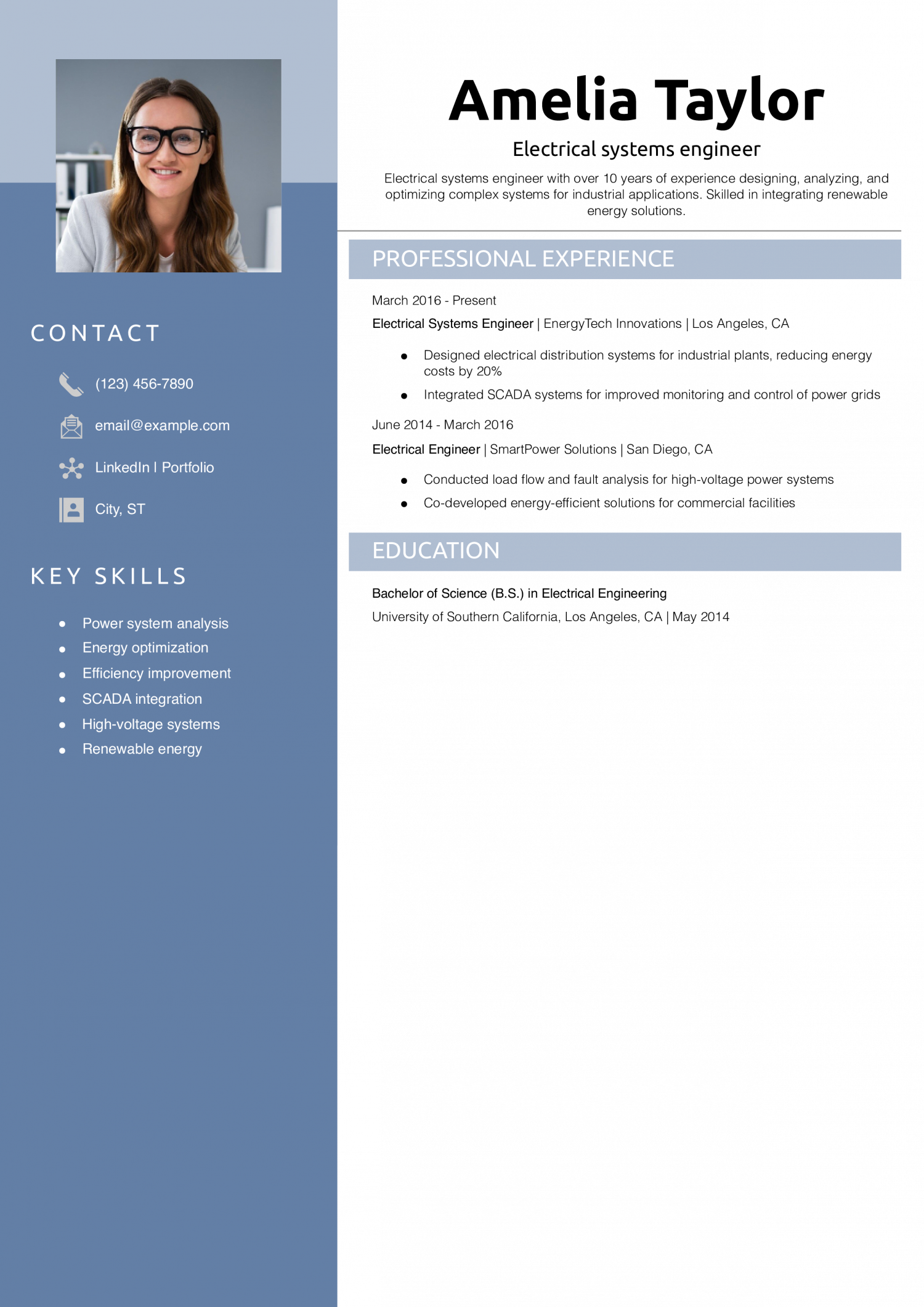
Why this electrical systems engineer resume is strong:
This resume highlights expertise in system design and measurable achievements in energy optimization. Learn how to effectively present system-level expertise here.
Power Distribution Engineer Resume Example
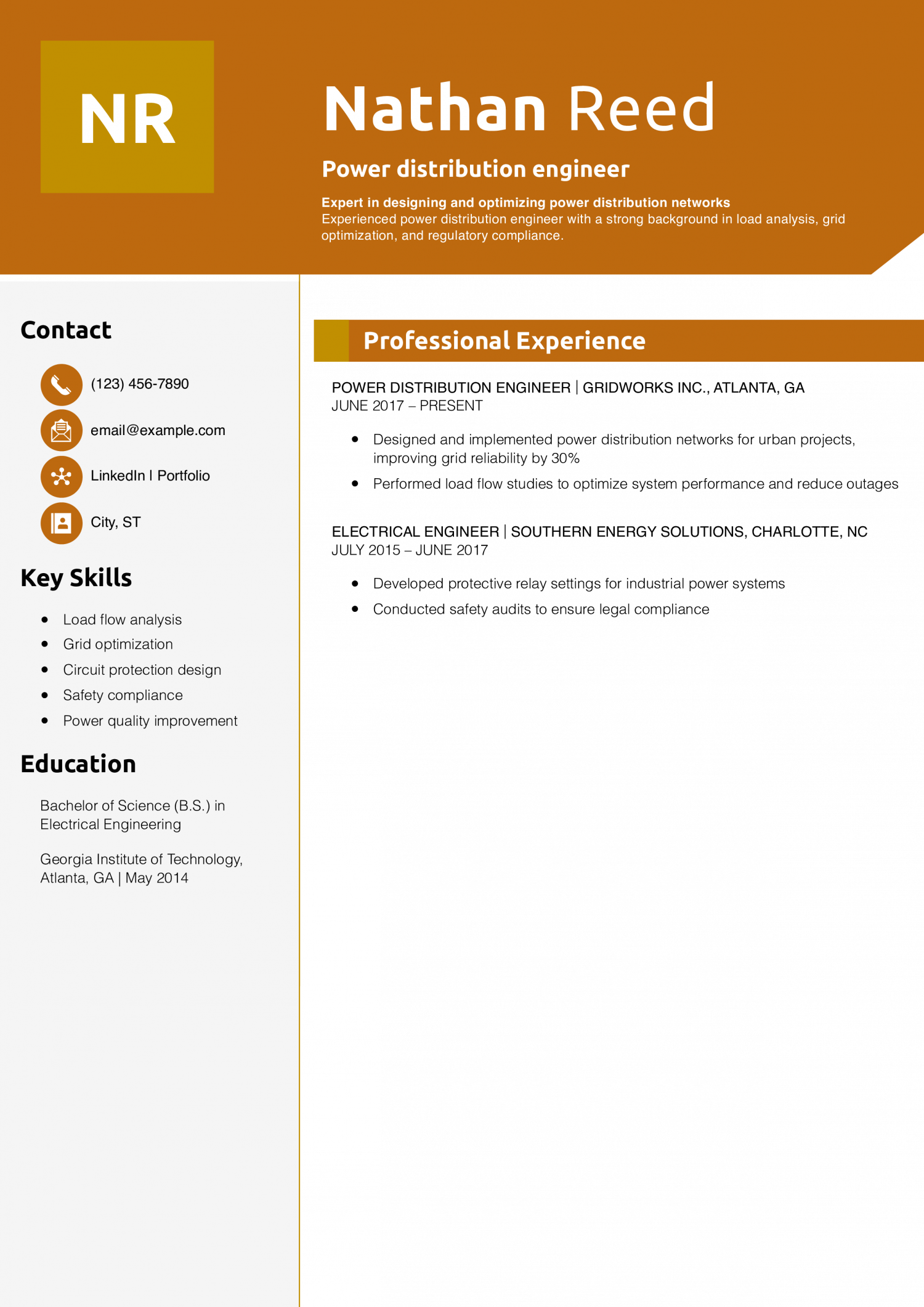
Why this power distribution engineer resume is strong:
This resume showcases technical expertise in power systems and grid optimization with quantifiable results. Learn how to align resumes with job postings here.
Electrical Project Engineer Resume Example

Why this electrical project engineer resume is strong:
This resume emphasizes leadership in managing high-value projects and reducing operational inefficiencies. Learn how to present project management skills effectively here.
Renewable Energy Electrical Engineer Resume Example
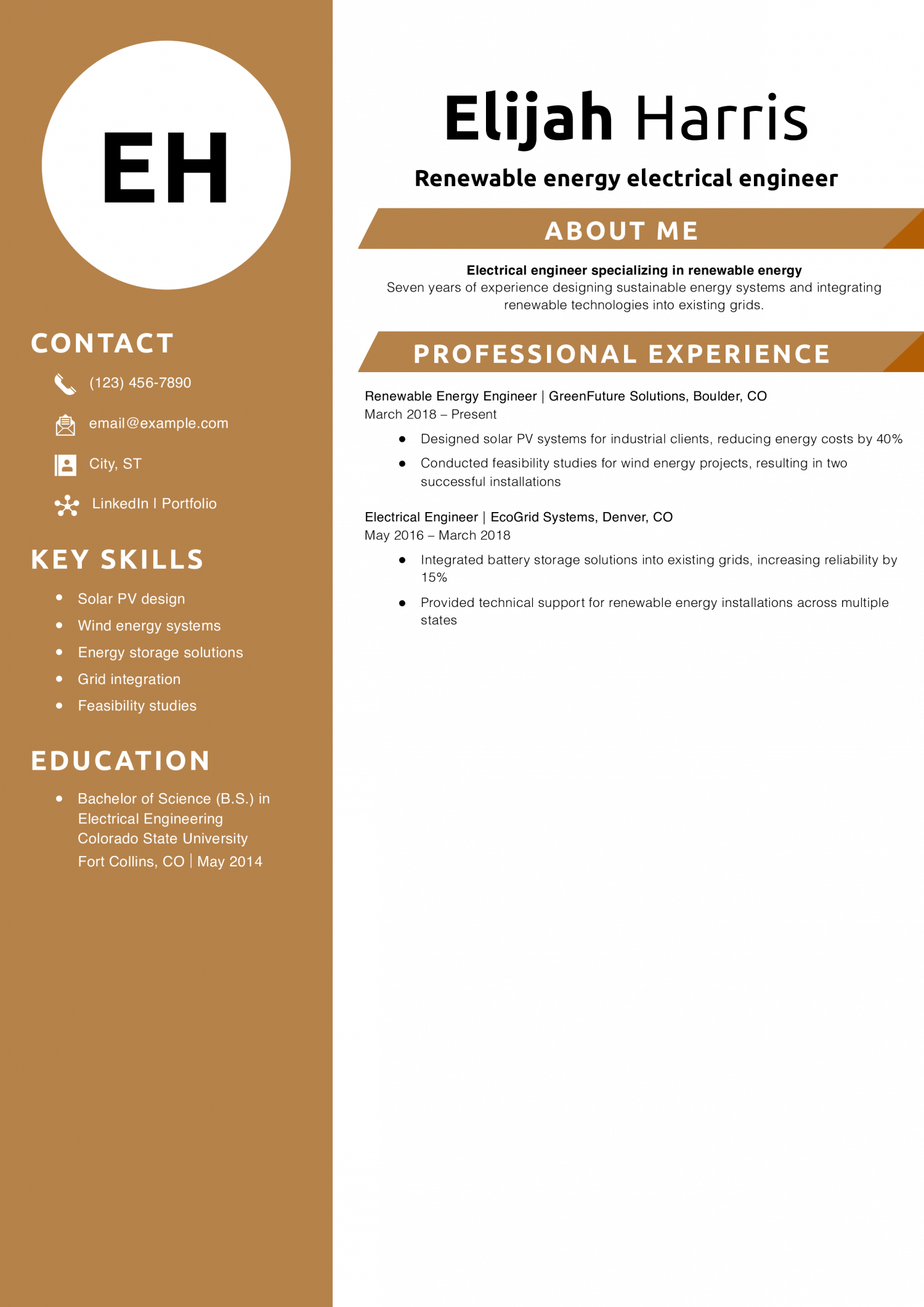
Why this renewable energy electrical engineer resume is strong:
This resume shows a strong focus on sustainability and renewable energy solutions with measurable project outcomes. Learn how to tailor resumes for niche fields here.
Electrical Reliability Engineer Resume Example
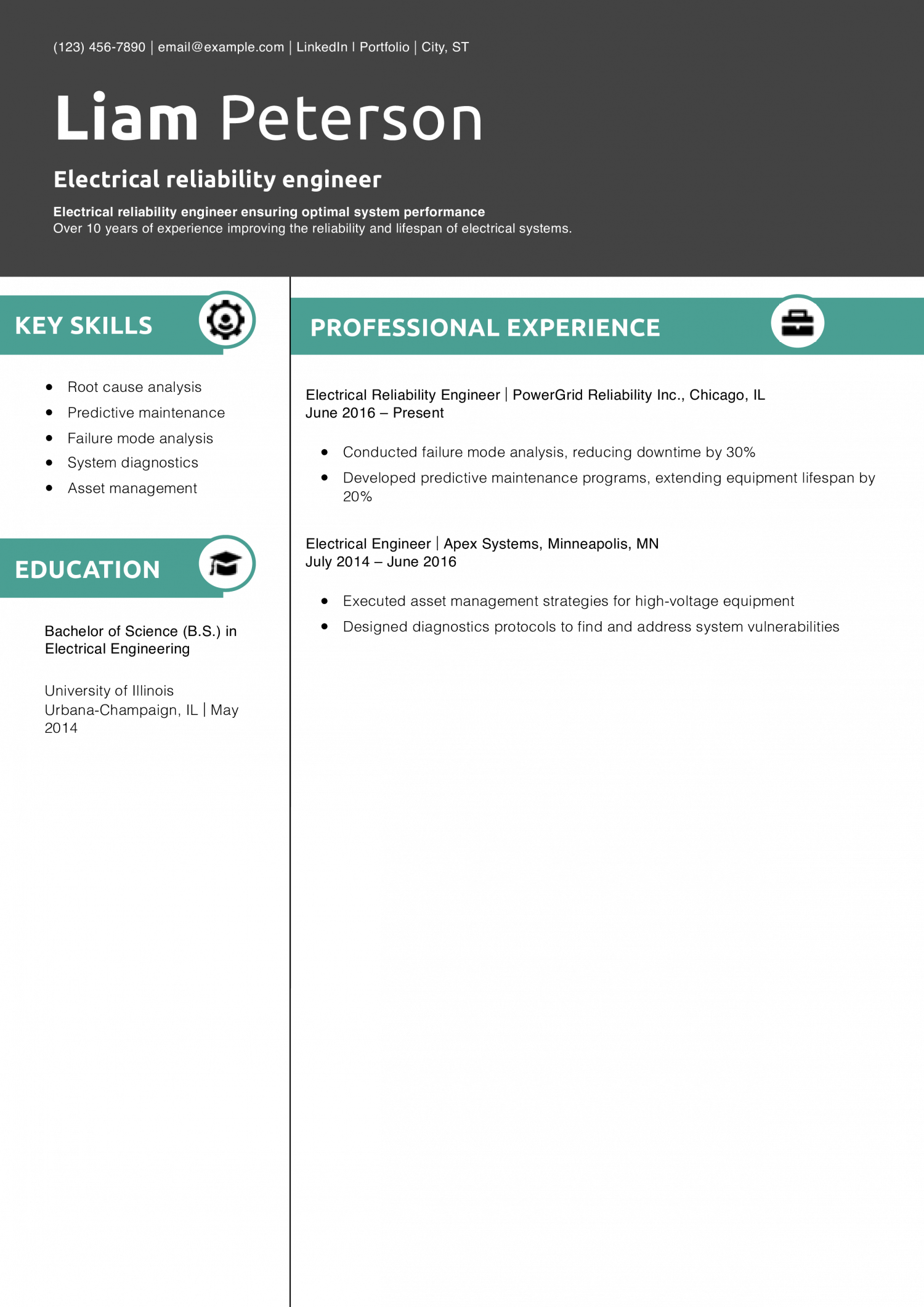
Why this electrical reliability engineer resume is strong:
This resume highlights expertise in reliability engineering, with a focus on reducing downtime and increasing equipment efficiency. Read more: Professional Hard Skills for Resume With Examples, Tips, and Guide
Substation Engineer Resume Example
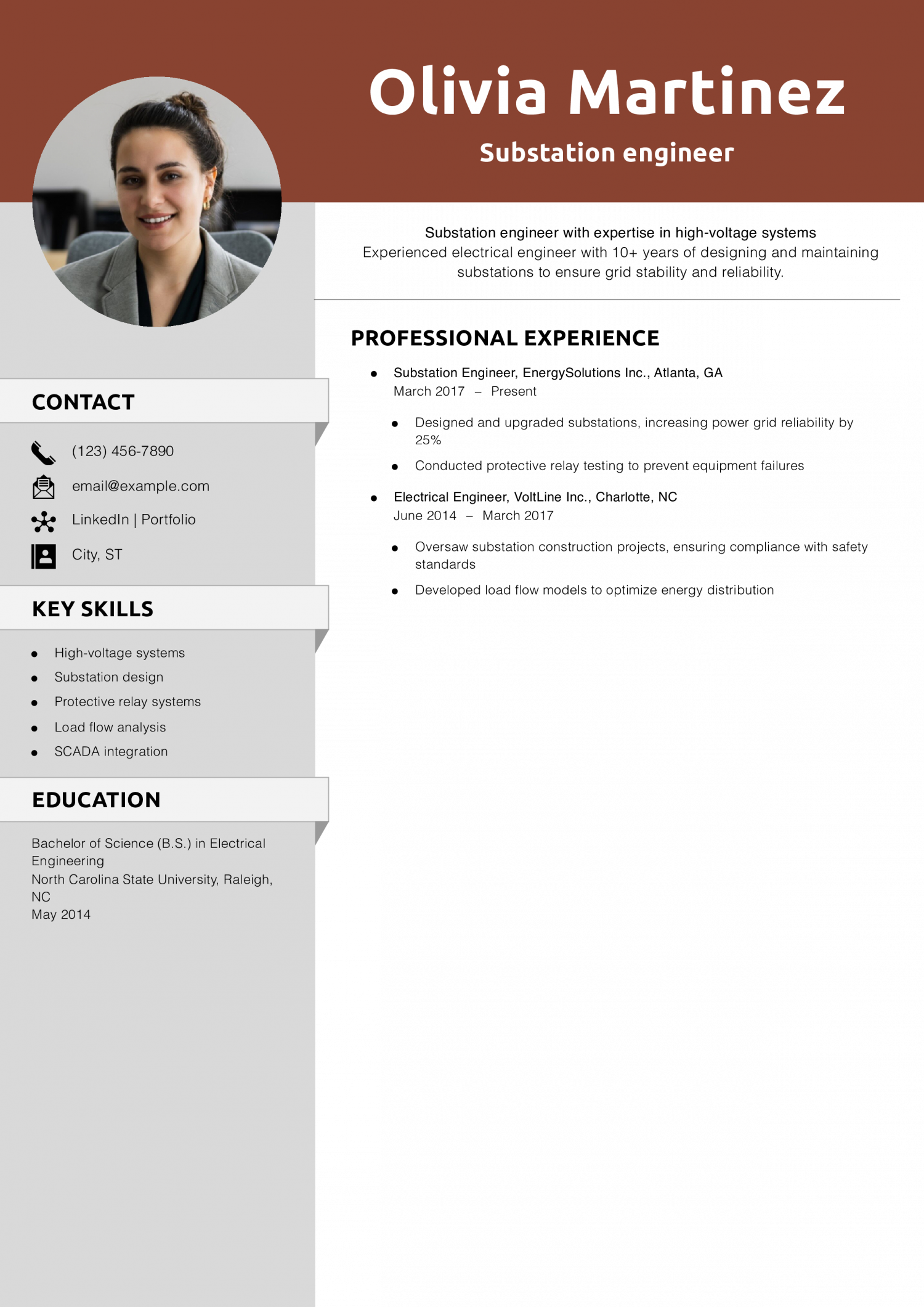
Why this substation engineer resume is strong:
This resume emphasizes technical expertise in substation design and system optimization, supported by measurable results. Read more: Action Verbs, Power Words, and Strong Synonyms to Use on Your Resume
Electrical Instrumentation Engineer Resume Example
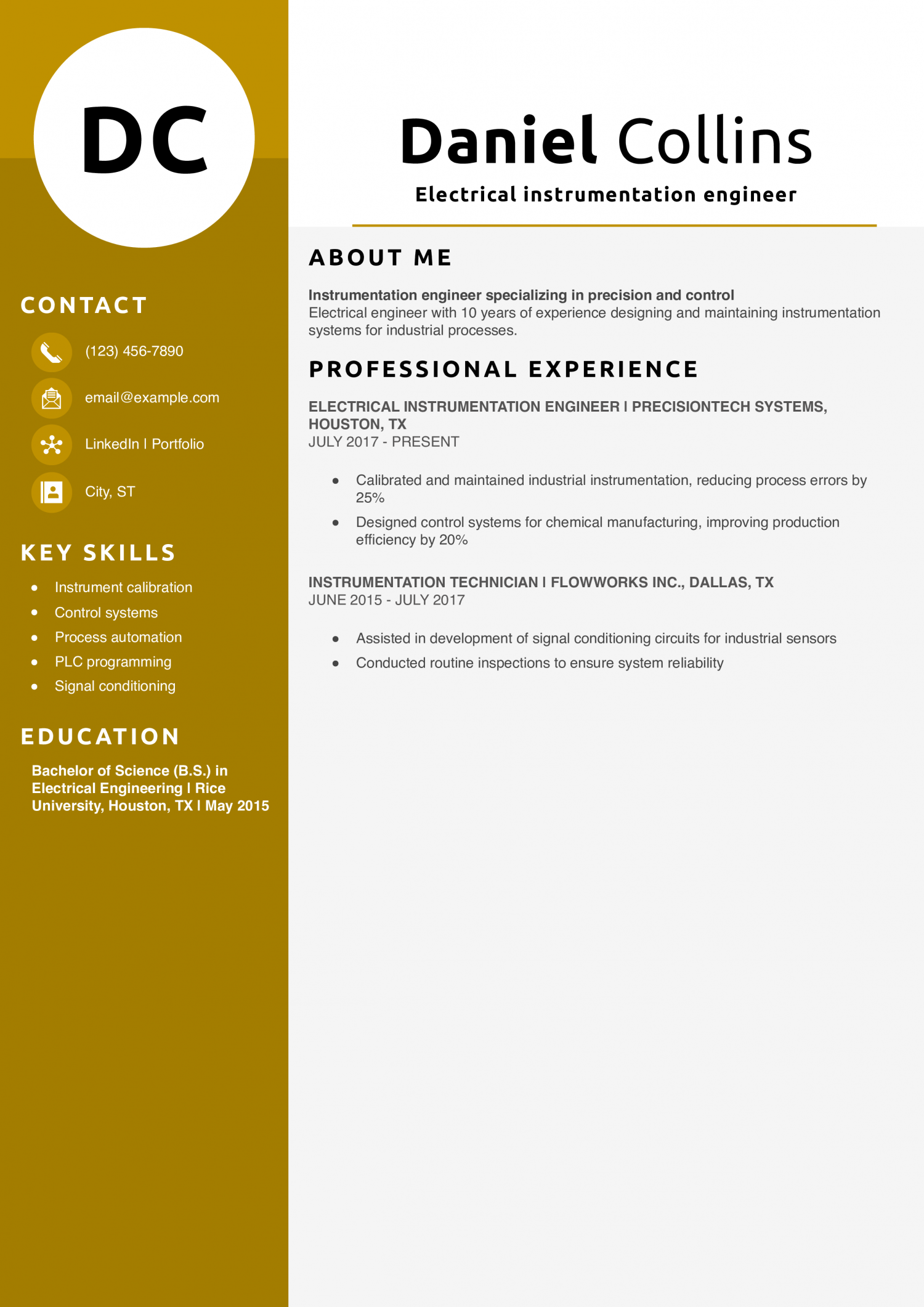
Why this electrical instrumentation engineer resume is strong:
This resume showcases technical skills in instrumentation and quantifiable contributions to improving industrial processes. Learn how to highlight technical roles effectively here.
Electrical Testing Engineer Resume Example
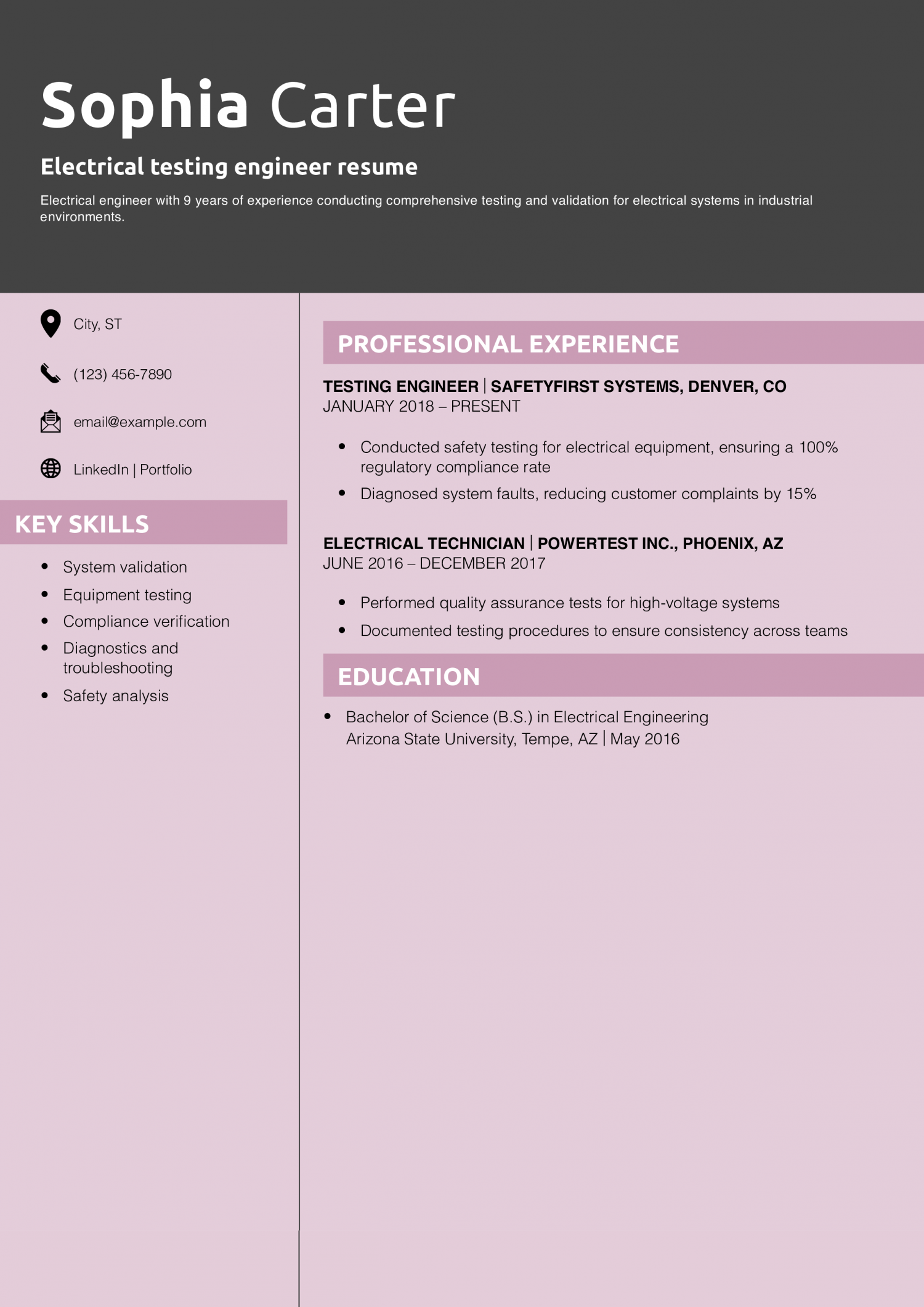
Why this electrical testing engineer resume is strong:
This resume emphasizes a focus on safety and compliance, with measurable results in improving reliability and customer satisfaction. Read more: How To Write a Convincing Resume Profile
Renewable Energy Systems Engineer Resume Example
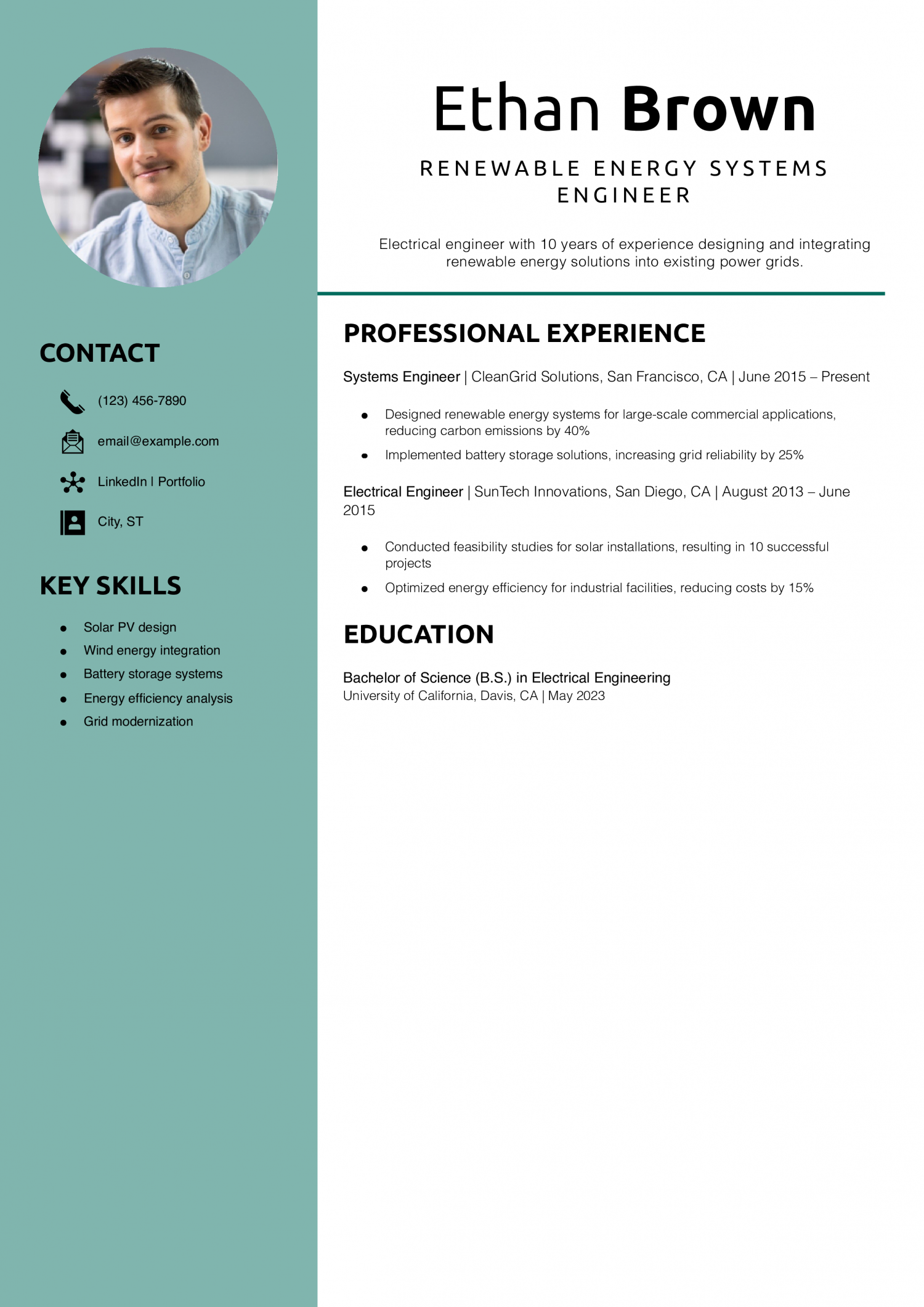
Why this renewable energy systems engineer resume is strong:
This resume highlights a focus on sustainability, supported by measurable contributions in carbon reduction and energy efficiency. Read more: How To Use Bullet Points on a Resume Effectively and How Many
Industrial Electrical Engineer Resume Example
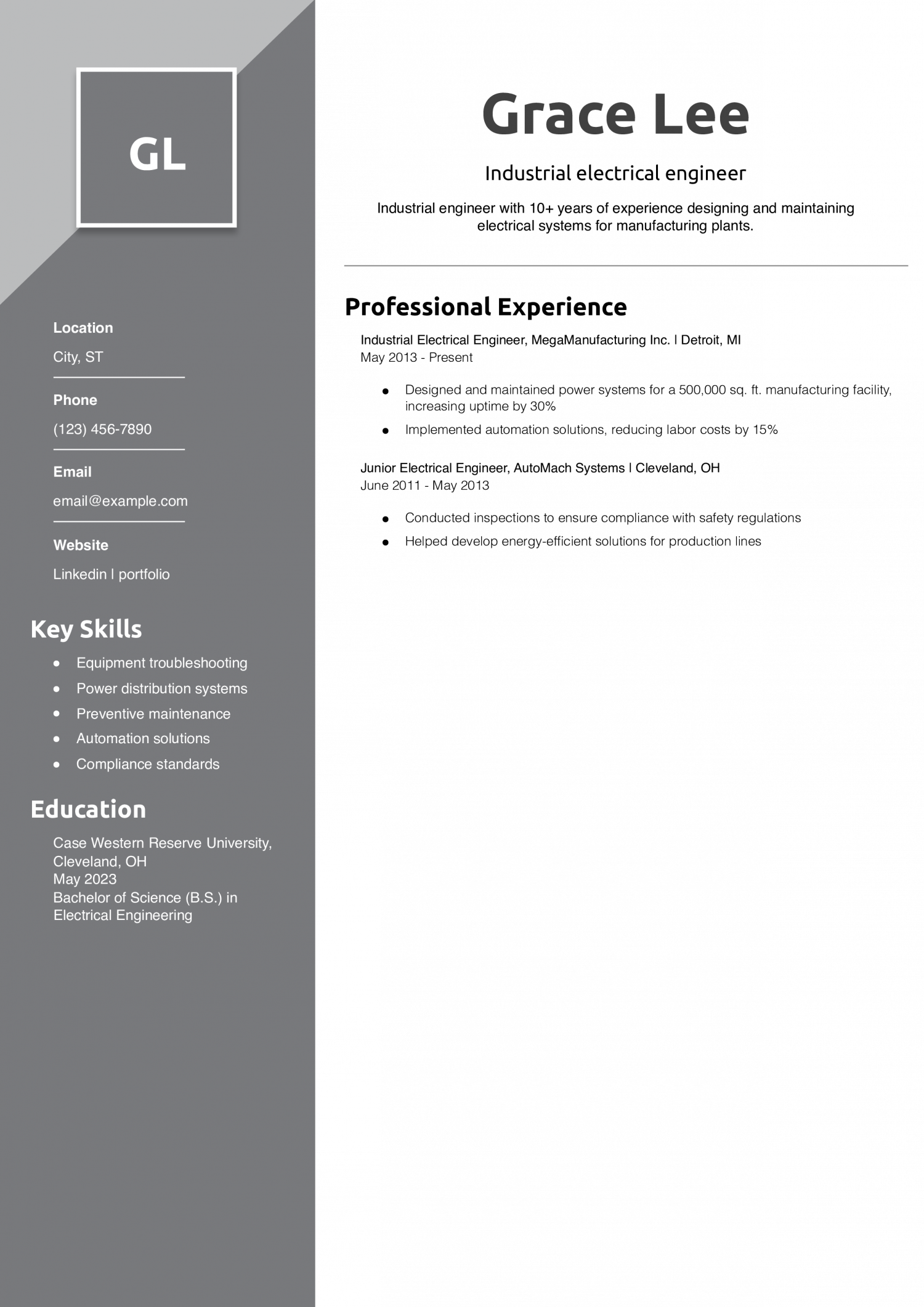
Why this industrial electrical engineer resume is strong:
This resume demonstrates expertise in industrial applications, with measurable improvements in system uptime and cost reduction. Learn how to present experience effectively here.
Electrical Engineer Text-Only Resume Examples and Templates
How To Write an Electrical Engineer Resume
Your electrical engineer resume should usually include these sections:
- Contact information
- Profile
- Key skills
- Professional experience
- Education and certifications
Below are tips and samples to help you organize each resume section.
1. Share your contact information
Give your full name, phone number, email address, location, and links to any online professional profiles. Ensure your contact information is current so employers can reach you for an interview.
Template
Your Name
(123) 456-7890 | [email protected] | City, ST 09876 | LinkedIn
2. Write a compelling profile summarizing your electrical engineer qualifications
Impress hiring managers at the top of your resume by giving the three to five primary reasons you’ll excel as their next electrical engineer. These key selling points may include your:
- Main strengths or engineering specialties
- Work style or approach (efficient, diligent, collaborative…)
- Advanced degree(s) or certifications in your field
- Rare technical skills
When writing this section, use simple, direct phrases like “skilled in” or “focused on,” and avoid elevated language and adjectives like “outstanding” or “exceptional.”
(Note: Most job seekers find it easier to write their profile last.)
Senior-level profile example:
Senior electrical engineer with over 10 years of experience in power systems and renewable energy solutions. Proven success leading multimillion-dollar projects, improving system reliability by 30%, and reducing energy costs by 25%.
Entry-level profile example:
Electrical engineer with a strong foundation in embedded systems, PCB design, and MATLAB programming. Adept at collaborating with cross-functional teams to develop original solutions for real-world challenges.
3. Add an accomplishment-driven professional experience section
View the experience section as a chance to give examples of your work and success in roles similar to the one you’re pursuing. For each job in your recent work history, brainstorm your duties and achievements on a separate document or sheet of paper. Then, choose the most relevant details to feature as bullet points in this section.
Senior-level professional experience example:
Senior Electrical Engineer, Apex Energy Solutions, Austin, TX | May 2015 to present
- Designed and implemented power systems for industrial facilities, increasing efficiency by 40% and reducing downtime by 25%
- Led cross-functional teams to complete projects valued at $15 million, consistently meeting deadlines and budgets
- Developed renewable energy solutions that reduced carbon emissions by 20% for clients
Entry-level professional experience example:
Electrical Engineer Intern, VoltTech Innovations, Denver, CO | June 2021 to August 2022
- Co-developed PCB layouts and wiring diagrams, contributing to the launch of three products
- Performed testing and troubleshooting for embedded systems, achieving a 95% pass rate in quality assurance
- Partnered with engineers to integrate IoT technologies, enhancing device performance by 15%
Resume writer’s tip: Quantify your experience
When possible, use relevant performance data to measure the results you’ve achieved as an electrical engineer. Hard numbers like percentages and dollar amounts put your work in context and give recruiters a better sense of your impact.
Do
- “Designed industrial circuits that improved system reliability by 20%”
Don’t
- “Designed circuits for industrial use”
Resume writer’s tip: Tailor your resume to each application
Before sending your resume, review it carefully against the job posting. Delete any details that don’t speak to the requirements, and consider using that space for more information about your relevant experience. This process takes extra time, obviously. But it can shorten your overall job search by giving you an edge over the many applicants who submit a more general, less convincing resume.
What if you have no work experience?
Focus on your other credentials. Omit the “Professional Experience” section, and instead fill the page with details on relevant skills you’ve gained or projects you’ve worked on as an intern, volunteer, or student.
Regardless of your background, know that resumes are flexible. They can and should take whatever shape and structure they need to present your qualifications for the job, whether that means a lengthy work experience section or none at all.
4. Include relevant education and certifications
With the education and certifications sections, you can show you have a strong knowledge base in your field. Each degree or credential also serves as a formal endorsement of your skills and professionalism. The following are templates to help you organize this information on your resume. (Note: Leave out graduation dates if they’d put you at risk of age discrimination.)
Education
Template:
[Degree Name], [School Name], [City, ST] | [Graduation Year]
[Relevant honors, coursework, or activities]
Example:
Bachelor of Science (B.S.) in Electrical Engineering, San Jose State University, San Jose, CA
Certifications
Template:
[Certification Name], [Awarding Organization] | [Completion Year]
[Description if the credential is lesser-known but relevant]
Examples:
Professional Engineer (PE) License, NCEES
Certified Energy Manager (CEM), AEE
5. List pertinent key skills
A separate skills section lets you quickly display the various ways you can add value to an organization. Below, you’ll find some key terms and skills to consider for this section:
| Key skills | |
|---|---|
| AutoCAD | Circuit design |
| Embedded systems | Energy efficiency |
| MATLAB | Microcontrollers |
| Power systems | Project management |
| Renewable energy | SCADA systems |
| Troubleshooting | |
Resume writer’s tip: Use specific action verbs
Start each bullet point with a strong action verb. Dynamic verbs help you keep the hiring manager’s attention and tell a compelling story about your experience.
The following list can help you find a good mix of action verbs for your electrical engineer resume:
| Action verbs | |
|---|---|
| Analyzed | Created |
| Decreased | Designed |
| Developed | Enhanced |
| Fostered | Generated |
| Grew | Improved |
| Increased | Introduced |
| Isolated | Launched |
| Lowered | Managed |
| Optimized | Organized |
| Prevented | Ranked |
| Reduced | Reversed |
| Solved | Streamlined |
| Tested | Updated |
| Won | |
How To Pick the Best Electrical Engineer Resume Template
A resume is a simple tool for professional communication and should be formatted that way. Choose a template that’s clear and straightforward, and avoid any with elaborate graphics or various colors and font styles. Simple resume design helps a hiring manager scan for relevant information. It also helps you tailor the document to each job application and update your work history going forward.
Frequently Asked Questions: Electrical Engineer Resume Examples and Advice
Focus on editing your skills section. With just a few quick changes to this section, you can hone your resume and help it get past screenings by applicant tracking systems (ATS).
First, take a close look at the job posting and highlight any skills required. Then, compare those highlighted terms against your resume's existing skills section. Delete any skills from your list that don't appear in the job posting, and add any missing skills of yours that do.
Say the job posting calls for experience in training new hires, which you have. Add the phrase "New hire training" to your skills section so ATS and human readers can see you have the leadership ability they're looking for.
The combination (or hybrid) format, because it lets you present yourself both clearly and strategically. According to job search experts Wendy Enelow and Louise Kursmark, this format "gives you many opportunities to share your specific successes.... It offers immense flexibility in an easy-to-follow structure."
A combination resume has these two features:
- An introduction to your strengths. Typically, the resume intro comprises a profile paragraph and skills list. But there are many variations. Depending on your job search, you may choose to omit one or both of these sections in favor of a one- or two-sentence professional headline. You may also add elements like graphs or client testimonials. Whatever approach you choose, make sure your introduction tells why you're great for the job.
- One or more experience sections. Hiring managers want to know your latest career activities. The combination format lets you provide that information with sections for your recent years' work, internship, education, or other experience. For most job seekers, the bulk of their combination resume will be a "Professional Experience" section with detailed job descriptions in reverse-chronological order.
Include a cover letter with your resume
A cover letter usually enhances your application – plan on sending one unless the job ad says otherwise. To write a standout letter, get specific. Tell the hiring manager why you’re interested in their organization and the electrical engineer role they hope to fill.
Check Out Related Examples
Resume Templates offers HR approved resume templates to help you create a professional resume in minutes. Choose from several template options and even pre-populate a resume from your profile.

